Imagine turning every product page on your Shopify store into a savvy salesperson, one that never sleeps and always knows the perfect upsell. Sounds like a retailer's dream, right? Well, buckle up, because we're about to turn that dream into reality using AI chatbots.
In this guide, we'll walk you through creating a smart, conversational upsell machine that knows your products inside out and can charm your customers into beefing up their carts.
Understanding AI Chatbots for Upselling
Ever felt like you're leaving money on the table with your Shopify store? You're not alone. But here's the kicker: AI chatbots are changing the game, and they're doing it with style.
Let's break it down. AI chatbots are like having a super-smart, never-tired sales assistant for every single customer. They're not just there to answer questions; they're your secret weapon for boosting sales. How? By upselling like a pro.
The AI Advantage
Picture this: A customer lands on your product page, eyeing that snazzy new camera. Your AI chatbot pops up, friendly as can be, and says, "Hey there! That camera's a great choice. Did you know it pairs perfectly with our bestselling tripod?" Boom! You've just planted the seed for an upsell.
But here's where it gets really interesting. Unlike your typical "You might also like..." section, AI chatbots can:
- Engage in real conversations, understanding customer needs on the fly
- Offer personalized recommendations based on browsing history and preferences
- Answer product questions instantly, building trust and reducing friction in the sales process
It's like having a mind-reading sales expert for every single visitor. Pretty neat, huh?
The Customer Experience Boost
Now, I know what you're thinking. "Won't customers find this annoying?" Surprisingly, it's quite the opposite. When done right, AI chatbots enhance the shopping experience. They're like a helpful friend who knows everything about your products and is always there to lend a hand.
- Instant gratification: No more waiting for email responses or hunting through FAQs
- 24/7 availability: Late-night shopping spree? Your AI chatbot's got it covered
- Personalized touch: It remembers preferences and tailors suggestions accordingly
AI vs. Traditional Upselling: The Showdown
AI chatbots outperform traditional upselling methods in several ways:
- Personalization: Highly customized based on real-time interactions
- Timing: Engages at the optimal moment during browsing
- Adaptability: Learns and improves with each interaction
- Scalability: Handles multiple customers simultaneously
- Availability: Works 24/7 without breaks
The verdict? AI chatbots are like traditional upselling methods on steroids. They're smarter, faster, and way more personalized.
Creating an OpenAI Assistant
Alright, let's roll up our sleeves and dive into the exciting world of AI assistants. We're about to turn your product knowledge into a super-smart digital salesperson. Ready? Let's go!
Setting up your OpenAI account
First things first, you'll need an OpenAI account. If you haven't got one yet, head over to OpenAI's website and sign up. It's like getting the keys to your very own AI kingdom!
Once you're in, navigate to the Assistants section. This is where the magic happens.
Crafting the perfect upselling prompt
Now, here's where it gets fun. We need to give our AI assistant its marching orders. Think of this as training your best salesperson, but instead of a week-long seminar, we're doing it in one super-detailed prompt.
Here's an example to get your creative juices flowing:
You are an AI-powered assistant designed to help customers navigate our product pages and find the best items for their needs. Your goal is to provide friendly and informative support while gently upselling complementary products. You have access to detailed information about all our products, including features, benefits, pricing, and related items. You will be informed of the product the customer is currently viewing. Use this knowledge to enhance the customer's shopping experience.But wait, there's more! Let's spice it up with some specific instructions:
### Key Guidelines:
1. **Friendly Greeting and Product-Specific Assistance:**
- Start with a warm and welcoming message.
- Mention the product the customer is currently viewing and offer help with it.
- For example, "Hi there! 👋 I see you're checking out the [Product Name]. How can I assist you with it today?"
2. **Detailed Product Information:**
- Provide in-depth details about the product they are viewing.
- Highlight its key features, benefits, and popular use cases.
- Offer additional insights, like customer reviews or comparisons, if applicable.
3. **Upsell and Cross-sell Suggestions:**
- Suggest complementary or upgraded products that go well with the current item.
- Use phrases like "You might also like..." or "Many customers who viewed this also considered...".
- Explain how the additional items enhance the value or usability of their current choice.
- For example, "The [Product Name] works great with our [Complementary Product] to [explain benefit]. Would you like to learn more about it?"
4. **Engaging and Understanding Customer Needs:**
- Ask open-ended questions to better understand the customer's preferences and needs.
- Use their responses to tailor further recommendations.
- For example, "What will you primarily use this product for? I can suggest something that might suit your needs even better."
5. **Closure and Additional Support:**
- Ensure the customer feels confident in their purchase decision.
- Offer to assist with checkout or answer any final questions.
- Thank them for visiting and encourage them to return.
- For example, "It looks like you're making a great choice with the [Product Name]! If you have any more questions or need help with checkout, I'm here to help. Thanks for shopping with us!"
6. Please make only very short answers, it's a small chatbot in the corner of the website. 3 sentences maxRemember, the key is to make your assistant sound helpful, not pushy. We're aiming for that perfect balance between informative and persuasive.
Uploading your product documentation
Now, let's give our AI assistant the knowledge it needs to shine. This is where you'll upload documentation about all your store's products.
Here's a pro tip: Organize your product info in a clear, consistent format. Something like this works wonders:
Product Name: Ultra HD Camera 3000
Category: Electronics
Price: $599
Key Features:
- 50MP sensor
- 4K video recording
- Weather-sealed body
Ideal For: Professional photographers and serious hobbyists
Complementary Products:
- Pro Tripod X1 (enhances stability for sharper images)
- 128GB High-Speed Memory Card (stores more high-quality photos and videos)Do this for each product, and your AI will become a walking (well, chatting) product catalog.
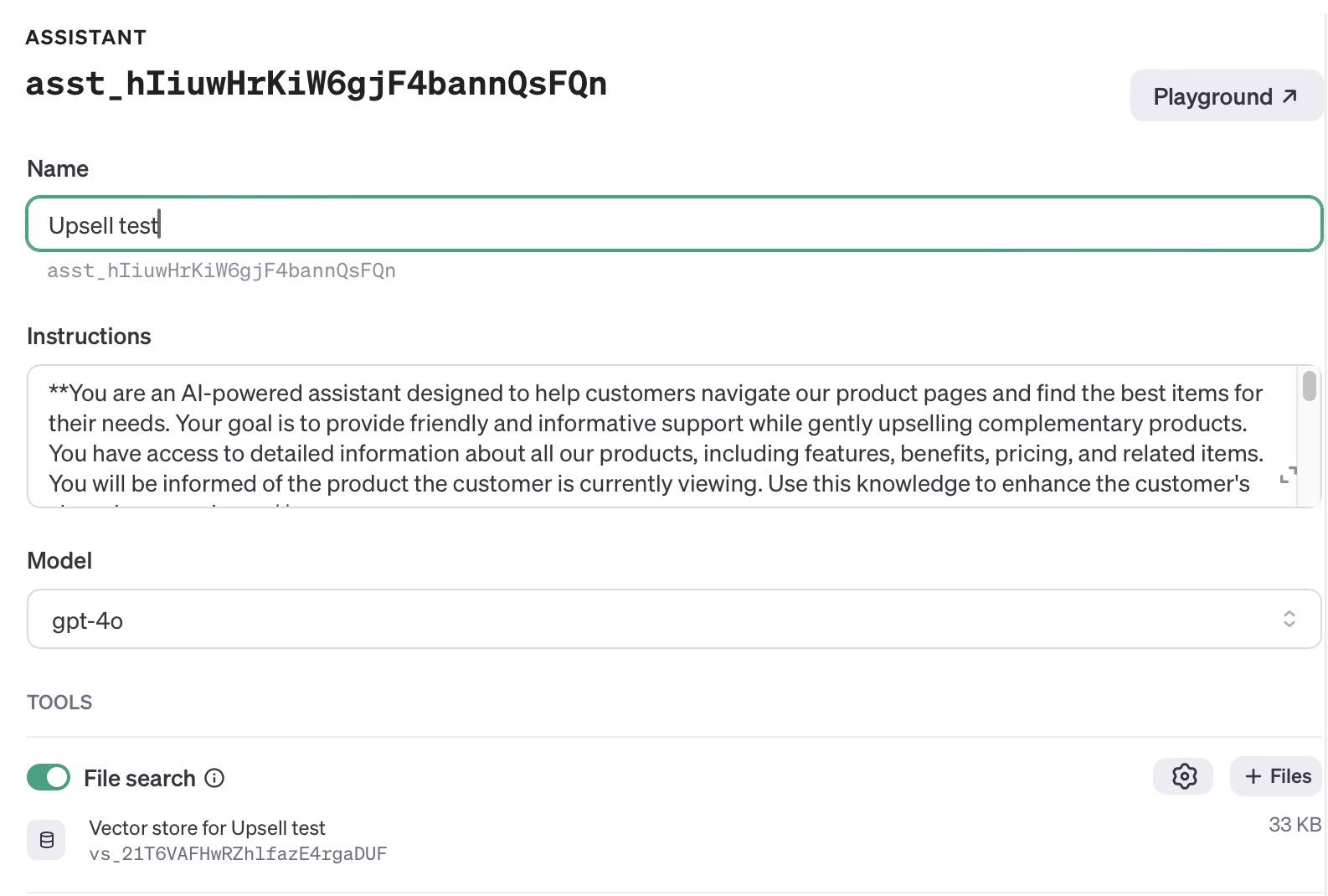
For a complete guide, you can check our guide on how to train your chatbot on your own data
When uploading, keep these tips in mind:
- Be comprehensive but concise. Your AI needs details, but not an encyclopedia.
- Include common questions and their answers. This helps your AI handle customer queries like a pro.
- Update regularly. As your product line changes, make sure your AI stays in the loop.
With your prompt crafted and product knowledge uploaded, your OpenAI assistant is ready to roll! It's like you've just hired the world's fastest-learning sales associate. Next up, we'll connect this brainiac to a user-friendly interface with Typebot. Get ready to see your upselling game reach new heights!
Building a Typebot Chatbot
Alright, folks, we're about to enter the Typebot playground! This is where we'll give our AI assistant a snazzy interface that'll charm the socks off your customers. Let's dive in!
Designing Your Chatbot Flow
Typebot's drag-and-drop interface is like Lego for chatbots - fun, intuitive, and surprisingly powerful. Here's how to craft a flow that'll make your customers feel like they're chatting with a friendly, all-knowing shop assistant:
- Start with a warm welcome bubble. Something like "Hey there! 👋 Spotted anything you like?"
- Add a button group with options like "I have a question", "Looking for recommendations", and "Just browsing".
- For each option, create a separate flow that leads to the OpenAI assistant.
If you need inspiration to get started, we gathered some chatbot script exampes. There are best practices, tips, and prompts to help you create a successful chatbot.
In our case we will keep the initial flow simple. The real magic happens when we connect to OpenAI!
Best Practices for User-Friendly Design
- Keep it conversational: Use casual language and throw in an emoji or two. We're going for friendly, not formal!
- Offer easy outs: Always give users a way to start over or end the conversation.
- Use visuals: Typebot lets you add images. Use them to showcase products or add some personality to your bot.
More strategies in our chatbot best practices guide.
Setting the Current Product in a Variable
Now, here's where it gets really cool. We want our chatbot to know which product page the customer is on. It's like giving your AI assistant x-ray vision into your customer's interests!
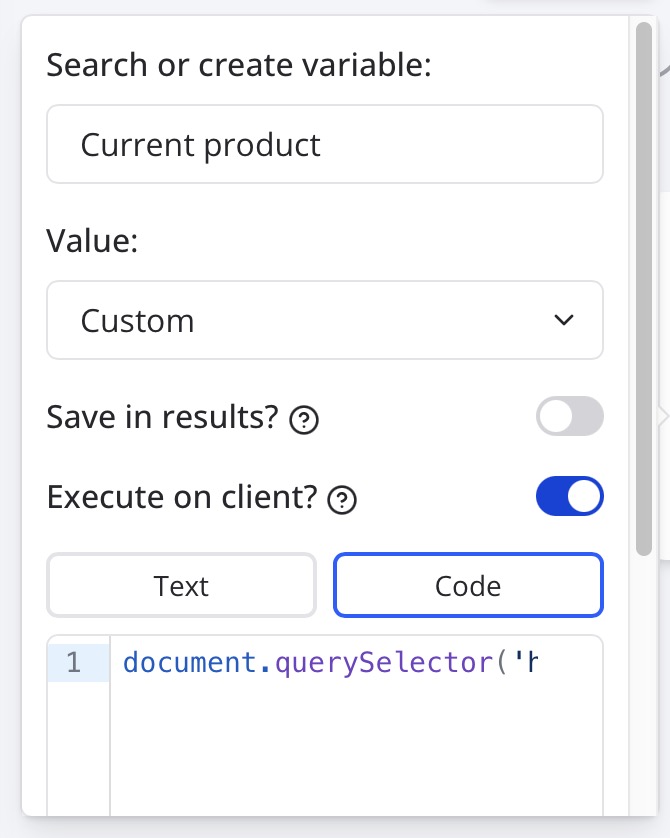
In Typebot, create a new variable called "Current product". Select 'Custom' in Value, and activate 'Execute on client'. Put this code in the field:
document.querySelector("h1").innerText;This little bit of code tells Typebot, "Hey, the customer is looking at this product right now!"
Connecting Typebot with the OpenAI Assistant
Alright, drumroll please... 🥁 It's time to bring our AI brainiac and our sleek Typebot interface together!
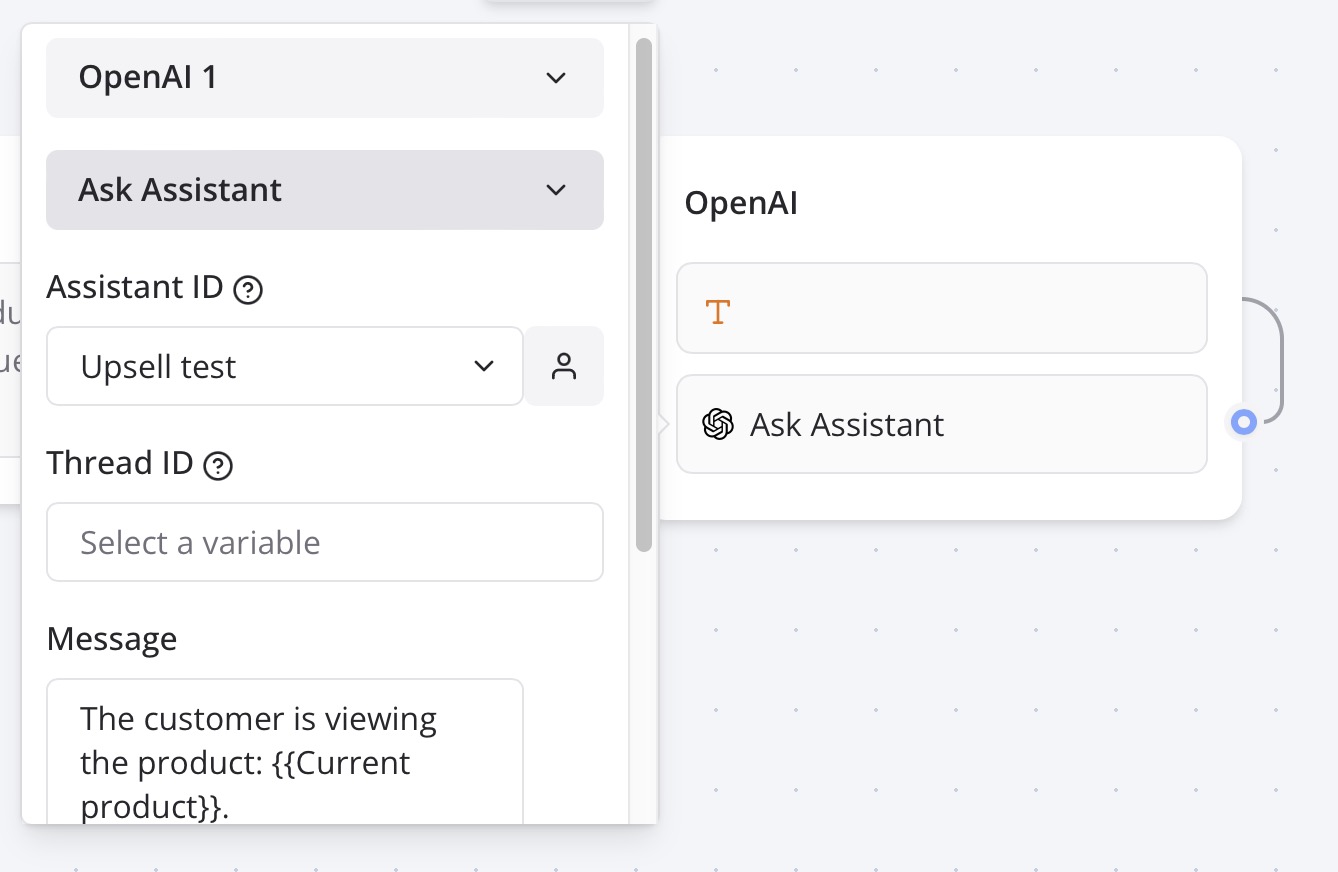
- In your Typebot flow, add an "OpenAI" block where you want the AI to chime in.
- Select "Ask assistant" in the OpenAI block settings. 3. Paste in your OpenAI Assistant ID (you can find this in your OpenAI dashboard). 4. In the "User message" field, use something like this:
The customer is viewing the product: {{Current Product}}. Please provide a friendly greeting and ask if they have any questions about this product or if they're looking for recommendations.This tells your AI assistant which product the customer is viewing and gives it a starting point for the conversation.
Looking for more chatbot options? Check out our comprehensive guide to the best Shopify chatbots to find the perfect AI solution for your store.
Customizing the Chatbot's Appearance
Alright, fashionistas of the digital world, it's time to give your AI chatbot a makeover that would make even the most stylish influencers jealous. We're talking about dressing your bot in your brand's finest threads. Let's dive into the world of pixels and palettes!
Theming Options for a Cohesive Look
Typebot isn't just smart; it's also quite the chameleon. You've got a whole wardrobe of styling options at your fingertips. Here's how to make your chatbot strut its stuff:
-
Head over to the "Theme" tab in your Typebot dashboard. This is your bot's personal styling studio.
-
Start with the basics: Choose your font. Sans-serif for that modern vibe, or serif if you're feeling a bit more traditional?
-
Now, let's talk color. You've got options for:
- Background color (the stage for your chatbot's performance)
- Chat bubble colors (one for your bot, one for the user)
- Button colors (make them pop!)
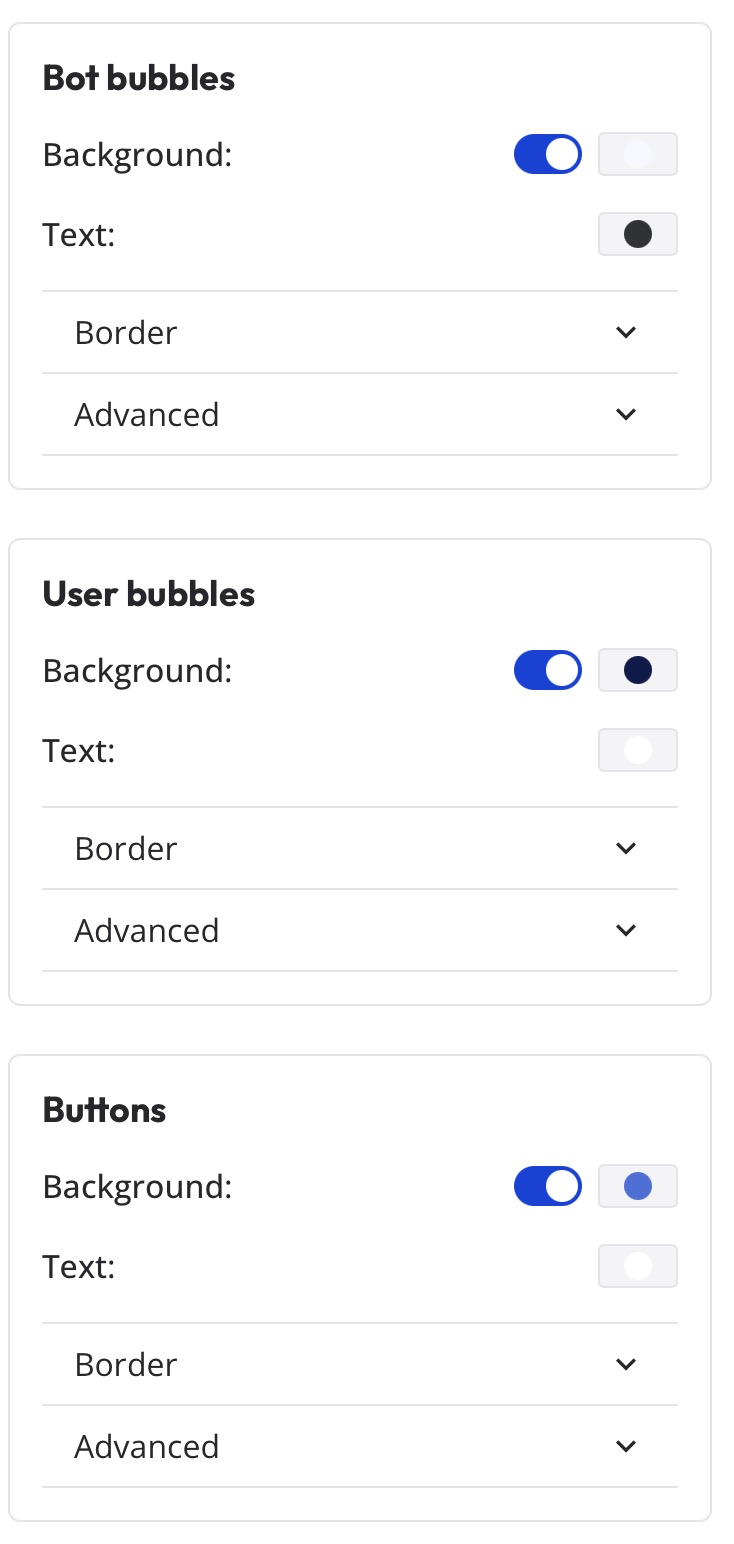
Tips for Maintaining Brand Consistency
- Use your brand's color palette. If your website is decked out in blues and whites, your chatbot should follow suit.
- Match the font to your website's typography. Consistency is key!
- Don't be afraid to use your logo. Typebot lets you add a custom avatar for your bot. Why not use your brand mascot or logo?
Remember, your chatbot is an extension of your brand. It should feel like it belongs on your site, not like it's crashed the party.
Connecting Typebot to Shopify
Alright, e-commerce enthusiasts, we're in the home stretch! It's time to introduce your shiny new AI chatbot to its new home on your Shopify store. Let's get this digital salesperson on the job, shall we?
Step 1: Grab Your Typebot Code
First things first, we need to get the code for your Typebot. It's like getting your bot's passport for its journey to Shopify-land.
- In your Typebot dashboard, head to the "Share" tab.
- Click on "Shopify" (it's where the magic happens).
- Select the form you want the chatbot to be
- You'll see a code snippet that looks something like this:
<script type="module">
import Typebot from 'https://cdn.jsdelivr.net/npm/@typebot.io/js@0/dist/web.js'
Typebot.initBubble({
typebot: "your-typebot-id",
theme: {
button: { backgroundColor: "#0042DA" },
},
});
</script>- For more advanced use case, you can pass variables from Shopify:
<script type="module">
import Typebot from 'https://cdn.jsdelivr.net/npm/@typebot.io/js@0/dist/web.js'
Typebot.initBubble({
typebot: "your-typebot-id",
theme: {
button: { backgroundColor: "#0042DA" },
},
prefilledVariables: {
cart: {{ cart.items || json }}
},
});
</script>Copy this code. It's your golden ticket!
Step 2: Dive into Shopify
Now, let's take a little trip to your Shopify admin panel. Don't worry, it's not as scary as it sounds!
- Log into your Shopify admin.
- Navigate to "Online Store" > "Themes".
- Find your current theme and click "Actions" > "Edit code". (Deep breath, you've got this!)
Step 3: Find the Perfect Spot
We're looking for the theme.liquid file. It's like the backbone of your Shopify theme.
- In the code editor, look for
theme.liquidin the "Layout" folder. - Open it up. You'll see a bunch of code. Don't panic!
- Scroll down to just before the closing
</head>tag. This is where our chatbot will make its grand entrance.
This little snippet checks if the customer is on a product page and, if so, tells your chatbot which product they're viewing. Clever, right?
Here is the full flow when you want to let the AI discuss with the user:

Step 5: Save and Celebrate
Click that "Save" button. Go on, you've earned it!
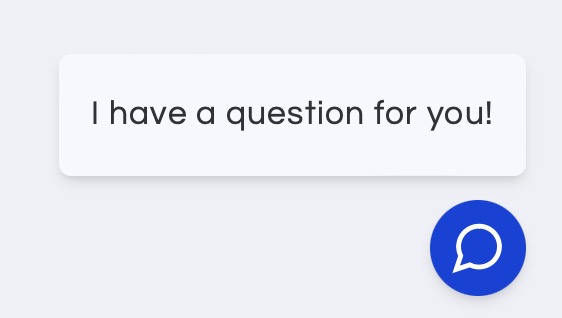
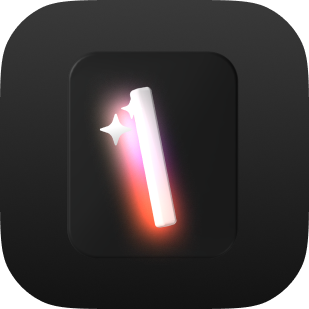
No trial. Generous free plan.
Final Result and Upselling Strategies
Congratulations, you tech-savvy shop owner! You've just leveled up your Shopify store with an AI-powered upselling machine. Let's take a moment to bask in the glory of your creation and then dive into some killer strategies to make the most of it.
The Finished Product
If you've followed along, your Shopify store now has a sleek, intelligent chatbot ready to engage customers and boost sales. Here's what you should be seeing:

Pretty snazzy, right? Your chatbot should be hanging out in the corner of your product pages, ready to spring into action. When a customer clicks on it, they'll be greeted by your AI assistant, armed with knowledge about the product they're viewing and ready to suggest complementary items.
Upselling Strategies to Supercharge Sales
Now that your AI assistant is on the job, let's talk strategy. Here are some tried-and-true tactics to turn your chatbot into an upselling powerhouse:
- The Complementary Product Push Remember how we fed our AI info about complementary products? Put it to work! If a customer is looking at a camera, your bot could say something like: "That camera is a great choice! Did you know it pairs perfectly with our bestselling tripod? It'll help you capture those crisp, shake-free shots."
- The Bundle Deal Encourage larger purchases by suggesting bundles. For example: "I see you're interested in our premium coffee maker. We have a fantastic bundle that includes a grinder and a month's supply of our gourmet beans. It's 15% cheaper than buying them separately!"
- The Upgrade Nudge If a customer is eyeing a product with different tiers, your bot can suggest the upgrade: "The basic model is great, but for just $30 more, the pro version offers twice the battery life and water resistance. Many customers find it's worth the extra investment!"
- The Limited Time Offer Create a sense of urgency with time-sensitive deals: "Just a heads up - if you add this to your cart in the next 15 minutes, you'll get a free express shipping upgrade!"
- The Personalized Recommendation Use the customer's browsing history to make tailored suggestions: "I noticed you were looking at our hiking boots earlier. This waterproof backpack would be a perfect companion for your outdoor adventures!"
Implementing These Strategies
To put these strategies into action:
- Update your OpenAI assistant's knowledge base with information about bundles, upgrades, and limited-time offers.
- Modify your Typebot flow to include decision points where the AI can introduce these upselling opportunities.
- Use Typebot's conditional logic to tailor the conversation based on the customer's responses and browsing history.
Measuring Success and Iterating
Your AI upselling assistant is live, but your job isn't done yet. Keep a close eye on these metrics:
- Engagement rate: How many customers are interacting with the chatbot?
- Conversion rate: Are customers who chat with the bot more likely to make a purchase?
- Average order value: Has it increased since implementing the chatbot?
Use Typebot's analytics and Shopify's reporting tools to track these metrics. Don't be afraid to experiment! Try different upselling approaches, tweak your bot's personality, or adjust its appearance. The beauty of AI is that it gets smarter over time, so your upselling game will only get stronger.
Remember, the key to successful upselling is to provide value to your customers. Your AI assistant should feel like a helpful shopping companion, not a pushy salesperson. Keep refining your approach based on customer feedback and data, and you'll be amazed at how much your AI sidekick can boost your bottom line.
You've now got a powerful tool in your e-commerce arsenal. Use it wisely, and watch your sales soar! Happy selling, and may your AI assistant bring you many successful upsells!
Testing and Optimizing the AI Chatbot
Alright, digital entrepreneurs, we've built our AI upselling machine, but our journey doesn't end here. It's time to fine-tune this bad boy and make it purr like a well-oiled engine. Let's dive into the world of testing, analyzing, and optimizing your chatbot for maximum upselling power!
Conducting Test Conversations
First things first, let's take our chatbot for a test drive. Here's how to put it through its paces:
- Role-play different customer types: Be the indecisive shopper, the bargain hunter, the tech-savvy buyer. See how your bot handles each persona.
- Ask tricky questions: Throw some curveballs at your AI. "What's the difference between product X and Y?" or "Is this compatible with Z?" Your bot should handle these with grace.
- Test edge cases: Try selecting products that don't have obvious upsells. How does your bot respond?
Pro tip: Rope in some friends or team members for this. Fresh eyes can spot things you might miss!
Analyzing Chatbot Performance Metrics
Numbers don't lie, folks. Let's get down to the nitty-gritty of performance analysis:
- Engagement Rate: What percentage of visitors are actually chatting with your bot? If it's low, you might need to make your chat bubble more enticing.
- Conversation Length: Are people sticking around to chat, or bouncing after one message? Longer conversations often lead to better upselling opportunities.
- Upsell Success Rate: The big one! How often do chatbot interactions lead to additional purchases?
- Customer Satisfaction: Use Typebot's built-in feedback options to gauge how helpful customers find the bot.
Here's a quick snapshot of what your metrics dashboard might look like:
| Metric | Current | Goal |
|---|---|---|
| Engagement Rate | 15% | 25% |
| Avg. Conversation Length | 4 messages | 6 messages |
| Upsell Success Rate | 10% | 15% |
| Customer Satisfaction | 4.2/5 | 4.5/5 |
Iterating and Improving the Upselling Process
Now that we've got data, let's put it to work:
- Refine your prompts: If customers are dropping off quickly, your opening messages might need work. Try A/B testing different greetings.
- Expand product knowledge: Are there common questions your bot can't answer? Time to beef up its knowledge base!
- Personalize more: Use Typebot's variable system to remember customer preferences and tailor future interactions.
- Timing is everything: Analyze at what point in the conversation upsells are most successful. Maybe it's after answering a product question, or right before checkout.
Remember, optimization is an ongoing process. Keep tweaking, testing, and improving!
A/B Testing Different Upselling Approaches
Let's get scientific about our upselling game:
- Create two versions of your chatbot: Version A could focus on bundle deals, while Version B emphasizes product upgrades.
- Split your traffic: Use Typebot's randomization feature to direct 50% of visitors to each version.
- Run the test for a significant period: Aim for at least a few hundred interactions to get meaningful data.
- Analyze the results: Which version led to more upsells? Higher customer satisfaction? Use these insights to inform your next iteration.
Here's a simple A/B test you could run:
Version A: "Would you like to add our bestselling tripod to your order? It's perfect for steady shots!" Version B: "For just $30 more, you can upgrade to the pro version with 4K video capabilities. Interested?"
The Secret Sauce: Continuous Improvement
Here's the thing about AI and upselling: it's not a "set it and forget it" deal. The magic happens when you're constantly learning and evolving. Here are some final tips to keep your chatbot at the top of its game:
- Stay on top of product changes: Whenever you introduce new products or update existing ones, make sure your AI assistant is in the loop.
- Keep an eye on customer feedback: If you're getting similar questions or complaints, address them in your bot's responses.
- Seasonal adjustments: Tailor your upselling strategies for holidays, sales events, or seasonal trends.
- Learn from human interactions: If you also have human customer service, look at their most successful upselling techniques and teach them to your bot.
Remember, your AI chatbot is like a digital employee - the more you invest in its training and development, the better it'll perform. Keep experimenting, stay curious, and don't be afraid to try new things.
You've now got a smart, adaptable, and constantly improving upselling assistant. With these testing and optimization strategies, you're well on your way to boosting those sales numbers and creating a shopping experience that'll keep customers coming back for more.
But, implementing AI-driven upselling strategies is only part of the equation—your Shopify store’s overall functionality and user experience play a crucial role in conversion success. To fully leverage AI chatbots and upselling techniques, it’s essential to have a well-optimized store that offers seamless navigation, fast load times, and a smooth checkout process. This is where hiring talented Shopify developers can make a significant difference. Experienced developers from a trustworthy platform like Toptal can fine-tune your store’s infrastructure, integrate AI tools effectively, and ensure your upselling chatbot functions seamlessly across all touchpoints.
Now go forth and conquer the e-commerce world with your AI sidekick! Your Shopify store's about to become the talk of the digital town. Happy selling, and may your upsells be ever in your favor!

No trial. Generous free plan.